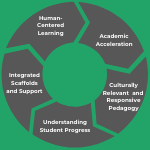Fractions
A robust body of research tells us that flexibility and accuracy with fractions are among the most critical elements for student success in later mathematics. One of the most important jobs of middle-grade elementary teachers is to support all children to build on their understanding of whole numbers and conceptualize fractions as part of the number system to fully reason, compute, and apply fraction understanding.
On this page, there is something for everyone—the classroom teacher, the coach, the instructional supervisor, and the principal—who needs great resources and support for their own learning of fractions as well as the teaching and learning of fractions with students. Use the navigation menu to find research and rationales, examples of fraction problems to use with students, and professional learning resources to build community and learning with colleagues.
Why Fractions?
The teaching and learning of fraction concepts is often quite complex. Many teachers were not themselves taught the critical mathematical concepts underlying fractions when they were students. (Remember the tricks?) Even in their professional training, many teachers have not had opportunities to engage in deep learning dedicated solely to fractions. Although understanding and mastery of fractions have critical implications for mathematical proficiency, these concepts and skills are not consistently prioritized in teacher preparation or professional development.
Further, the world around us bombards our students with images and language about fractions that work against our efforts. Have you ever heard someone say, when splitting a treat, “I want the bigger half!”? By definition, however, halves are equal. Imagine how confusing that language is for students beginning to build fraction understanding. They see drawings of fruit pies and pizza pies and are asked repeatedly to shade in parts of these pies. Does this help them see that a fraction is a number in and of itself, or does it reinforce the incorrect belief that a fraction is only a piece of a number, just a numeric slice of a whole pie?
Many students struggle with fractions, but students of color, students from families experiencing poverty, and English learners are less likely to have access to effective instructional practices, appropriate individualized supports, or teaching practices and materials that reflect their identities. To implement the study of fractions more equitably, we must consider student supports, culturally relevant content and practices, and aligned instructional materials. This means that educators must have a deep knowledge of fraction content and instruct in ways that value all students’ backgrounds, languages, cultures, points of view, knowledge, and skills. You’ll find these essential elements of teaching fractions throughout this collection.
 Supporting Social, Emotional, and Academic Development in Mathematics. It is clear that not only must attention be spent on fraction understanding and students’ academic development but we must also attend to their social and emotional needs. In this document, you will find a more detailed description of how to do this, including sample actions to support student agency, identity, and belonging.
Supporting Social, Emotional, and Academic Development in Mathematics. It is clear that not only must attention be spent on fraction understanding and students’ academic development but we must also attend to their social and emotional needs. In this document, you will find a more detailed description of how to do this, including sample actions to support student agency, identity, and belonging.
Coherence Map. The Coherance Map was incredibly useful in the design of this fraction learning experience. Here is a brief video, created by the Washington Core Advocates, that highlights the Coherence Map as a tool.
 Coherence Map Fraction Activity. Use this activity to look at standards across grade levels. Within each standard, spend some time reading the focus standard, excerpts from the Progression document relevant to that standard, and tasks that fall within the standard. Consider: what are the connections between standards and the downstream implications of students understanding fraction value based on unit thinking?
Coherence Map Fraction Activity. Use this activity to look at standards across grade levels. Within each standard, spend some time reading the focus standard, excerpts from the Progression document relevant to that standard, and tasks that fall within the standard. Consider: what are the connections between standards and the downstream implications of students understanding fraction value based on unit thinking?
 Fraction Guidance for Educators. Teaching of fraction content across individual classrooms and schools can vary dramatically. If your students seem to stumble when working with fractions, they might be missing some foundational fractions concepts. This guidance document is designed to help you identify some traditional practices that may be impeding student learning, and to provide ideas for alternate approaches.
Fraction Guidance for Educators. Teaching of fraction content across individual classrooms and schools can vary dramatically. If your students seem to stumble when working with fractions, they might be missing some foundational fractions concepts. This guidance document is designed to help you identify some traditional practices that may be impeding student learning, and to provide ideas for alternate approaches.
Fractions as Numbers
If you pose the question, “Are fractions numbers, and how do you know?” you might be surprised by the responses and rationales you get. The misconceptions you will find in these answers are indicative of what makes both the understanding and teaching of fractions complex. Throughout the following grade-level collections of tasks, you’ll find resources to support the thinking behind confident (and accurate) answers.
.png)
Yes, a fraction is a number because it may be placed on the number line.
As the story of fractions unfolds, it is important to stay connected to the progression laid out by the standards themselves, dig deeply, and allow for exploration and sensemaking. The unit fraction plays a critical role in this learning and is featured prominently within each grade-level collection. The grade-level collections intentionally highlight the number line over bar models and circular models to emphasize fractions to prior work with whole numbers, and do not include every NF standard or fully address the aspect of rigor in a single grade.
Grade 3 Tasks
.png)
This entry task is one of the seven examples from this grade-level collection. It serves as a bridge between students’ prior work with whole numbers and the grade 3 introduction to fractions as numbers. It provides an entry point for the work of fractions that attempts to pique students' curiosity toward answering the question, “Why do we need numbers other than whole numbers, anyway?”
In grade 3, the focus is on fractions as numbers and expanding student thinking on the number line to include fractions as well as whole numbers.
 Grade 3 Fraction Tasks. This resource uses examples of problems to highlight the big ideas in fractions for grade 3. There are student work samples - sometimes written and sometimes in video, additional resources for instructional support, and questions to promote student identity, agency, and belonging as learners and doers of mathematics.
Grade 3 Fraction Tasks. This resource uses examples of problems to highlight the big ideas in fractions for grade 3. There are student work samples - sometimes written and sometimes in video, additional resources for instructional support, and questions to promote student identity, agency, and belonging as learners and doers of mathematics.
Grade 4 Tasks
.png)
This entry task shows the uptick from the work of grade 3 - where students compare fractions with like numerators or like denominators, to the work of grade 4 - where students compare fractions with unlike numerators and unlike denominators. This is one of the nine examples you’ll find within the grade-level collection.
In grade 4, the focus is on students applying what they understand about the concept of fractions to compare fractions and add and subtract fractions. Additionally, the domain steps it up a notch as students are introduced to decimals and reason about their size in comparison to fractions of tenths and hundredths.
 Grade 4 Fraction Tasks. This resource uses examples of problems to highlight the big ideas in fractions for grade 4. There are student work samples - sometimes written and sometimes in video, additional resources for instructional support, and questions to promote student identity, agency, and belonging as learners and doers of mathematics.
Grade 4 Fraction Tasks. This resource uses examples of problems to highlight the big ideas in fractions for grade 4. There are student work samples - sometimes written and sometimes in video, additional resources for instructional support, and questions to promote student identity, agency, and belonging as learners and doers of mathematics.
Grade 5 Tasks
.png)
This entry task serves as a bridge between students’ grade 4 skills of generating equivalent fractions and adding fractions with like denominators and the grade 5 expectation of adding fractions and fractions over one with unlike denominators. There is further description of this task, along with seven additional examples, to highlight the content of the grade.
In grade 5, the focus is on students extending their skills with whole number operations - adding, subtracting, multiplying, and dividing - to fractions.
 Grade 5 Fraction Tasks. This resource uses examples of problems to highlight the big ideas in fractions for grade 5. There are student work samples - sometimes written and sometimes in video, additional resources for instructional support, and questions to promote student identity, agency, and belonging as learners and doers of mathematics.
Grade 5 Fraction Tasks. This resource uses examples of problems to highlight the big ideas in fractions for grade 5. There are student work samples - sometimes written and sometimes in video, additional resources for instructional support, and questions to promote student identity, agency, and belonging as learners and doers of mathematics.
Grade 6 and Beyond Tasks
While the Number and Operations - Fractions domain spans grades 3-5, the study of fractions and their applications extends well beyond the elementary grades.
.png)
This task is designed to have students leverage their understanding of fractions as numbers developed across grades 3-5 and expand their known number system to now include rational numbers.
 Grade 6 and Beyond Fraction Tasks. This resource uses examples of problems to highlight the big ideas in fractions for grade 6 into high school. There are student work samples in written and/or video forms, additional resources for instructional support, and questions to promote student identity, agency, and belonging as learners and doers of mathematics.
Grade 6 and Beyond Fraction Tasks. This resource uses examples of problems to highlight the big ideas in fractions for grade 6 into high school. There are student work samples in written and/or video forms, additional resources for instructional support, and questions to promote student identity, agency, and belonging as learners and doers of mathematics.
 Grade 6 Do Nows. As students progress through elementary and middle grades, it is important to bring them into grade-level content in such a way that affirms knowledge they already hold. The Do Now resources are meant to be used at the onset of class to bring students into the grade 6 content of Ratios and Proportional Reasoning. The resources pair a student work page with a teacher’s guide that contains instructional questions and language supports as well as annotated student work.
Grade 6 Do Nows. As students progress through elementary and middle grades, it is important to bring them into grade-level content in such a way that affirms knowledge they already hold. The Do Now resources are meant to be used at the onset of class to bring students into the grade 6 content of Ratios and Proportional Reasoning. The resources pair a student work page with a teacher’s guide that contains instructional questions and language supports as well as annotated student work.
Coaches & Instructional Leaders
.jpeg) Coaches and instructional leaders do important work to support teachers and students engaging with fractions content. The resources below are intended to help ensure high-quality professional learning and coaching.
Coaches and instructional leaders do important work to support teachers and students engaging with fractions content. The resources below are intended to help ensure high-quality professional learning and coaching.
 Question the Image Fraction Activity. Use this professional learning activity to examine and discuss possible images and visuals you and your students may encounter in fraction units of study. Are the fraction images students are presented with supporting their learning or impeding their understanding?
Question the Image Fraction Activity. Use this professional learning activity to examine and discuss possible images and visuals you and your students may encounter in fraction units of study. Are the fraction images students are presented with supporting their learning or impeding their understanding?
Resources to Support All Learners
Resources to Support Adult Learning
- Principles for High-Quality, Standards-Aligned Professional Learning Principles
- Integrating Curriculum and Assessment: An Example from Grade 3 Fractions Webinar
- K-12 Instructional Practice Guide for Coaching Guide
Resources to Support Equitable Instruction
- Awake to Woke to Work: Building a Race Equity Culture (Equity in the Center) Professional Learning
- The Mo(ve)ment to Prioritize Antiracist Mathematics: Planning for This and Every School Year (TODOS - Mathematics for All) Professional Learning
- Social, Emotional, and Academic Development Through an Equity Lens (EdTrust) Report


